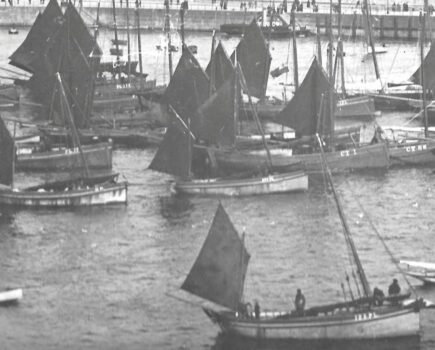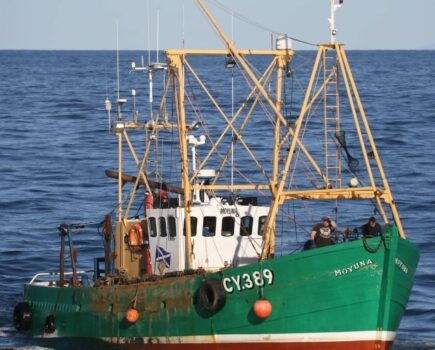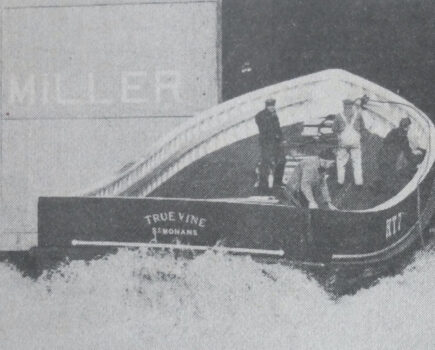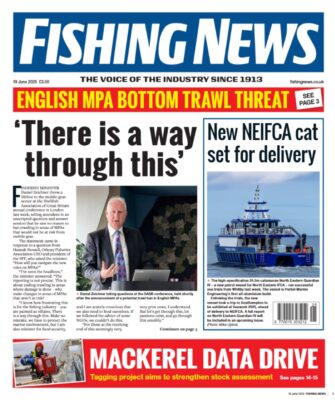In the second of a new occasional series, David Linkie looks back on fishing trips – some of them in fisheries now sadly consigned to history – that he has experienced over the past 30-plus years
Balanced fisheries have been of crucial importance for generations of inshore fishermen. How this was achieved clearly varied considerably depending on geographical location.
For some, it involved seasonal changes from one type of fishing method to another, such as jigging, potting, netting and longlining. In other areas, a balance of fishing effort, and therefore catch diversity when possible, was delivered on a daily basis.
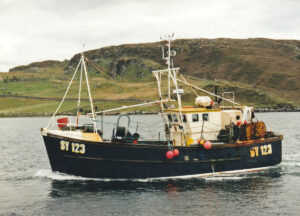
The versatile Dunan Star II heads into the pier at Carloway in East Loch Roag, Lewis.
To the detriment of many, this degree of flexibility has been deeply eroded over the past four decades, and in many instances, it has been lost forever. Every time new rules and regulations were put in place, supposedly to conserve stocks, doors began to close on small-scale fisheries that had sustained generations of fishermen and their families.
The situation today, where every vessel is tightly pigeonholed by entitlement, therefore maximising effort on particular stocks, is far removed from that which prevailed less than 30 years ago. This highlights the rapid rate of change that the fleet has been subjected to in a relatively short period of time, as what were initially thought to be comparatively small amendments stealthily snowballed, to marked cumulative effect.
The benefits of being able to engage in a balanced fishery – which in turn went a long way towards underpinning financial viability in remote coastal communities – were made abundantly clear when the opportunity arose in July 2001 to spend a day with Western Isles skipper Calum MacLeod and his crew on the Carloway-based inshore boat Dunan Star II SY 123.
Before Dunan Star II left Carloway pier at 5am on a breezy Monday morning, with the intention of splitting the day between gill-netting and trawling, 20 berried hen lobsters, caught the previous week, were removed from a holding cage. Their carapace length and weight were recorded and their tails were V-notched, as part of what proved to be a highly successful two-year scheme introduced by the Western Isles Fishermen’s Association.
While not being the first activity normally associated with the start of a gill-netting trip, this showed the importance of inshore vessels engaging in a balanced and mixed fishery, which offers advantages with regard to both marketing of the catch and stock conservation.

Hauling dogfish gill-nets onboard Dunan Star II…
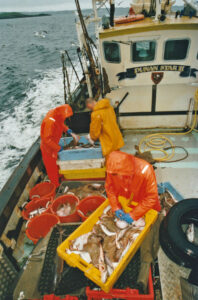
… and sorting a haul of groundfish taken later in the day while trawling near Gallan Head.
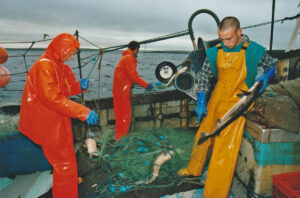
Dunan Star II’s crew are kept busy by a small run of dogfish.
After clearing the approaches to East Loch Roag, Dunan Star II headed northeast towards the Butt of Lewis.
An hour after throwing off the ropes, and with Dunan Star II off the small community of Barvas, the crew were called on deck. After throwing back the V-notched lobsters, Calum MacLeod eased Dunan Star II up to the buoy indicating the northern end of the first fleet of gill-nets, which had been fishing in 15 fathoms of water on sandy bottom, just behind the kelp beds and a couple of miles offshore.
The buoy, end rope and anchor were taken through the Spencer Carter net hauler before the first net and a promising run of spurdogs started to spill onto the deck. Three days earlier, when Douglas Craigie had the boat for a day, Dunan Star II landed 60 boxes of top-quality dogfish, and with a dozen large bitches showing in the first few fathoms of netting, hopes of a similarly successful day were rising rapidly.
There are times, however, when first impressions are wrong, and this was one of them, as the rest of the first fleet yielded very few more – yet another reminder of just how unpredictable a quarry spurdog was.
The gill-nets used by Dunan Star II for targeting dogfish were 30 x 4.75in meshes deep, made from three-stranded multi-mono twine. The nets were usually fished in fleets of 6 x 120-yard nets, hung in by a third. Participating every day in a mixed fishery, centred on netting, trawling and potting, effectively restricted the quantity of gill-nets that Dunan Star II fished.
Being rigged for trawling and potting in addition to gill-netting left insufficient room on Dunan Star II to fit a net-cleaner, without restricting the boat’s ability to always be ready to engage in an alternative catching method. Not working miles of gill-net meant that the crew had no problems in clearing and flaking gill-nets into bins.
After the six nets of the first fleet were aboard, and lying on a canvas sheet aft of the hauler, this pile of netting was pulled clear. This enabled Douglas Craigie and Mustaffa Murray to start turning the nets over and flaking them into a bin ready for shooting again, while Aulay MacKay manned the hauler and brought in the second half of the fleet, with skipper Calum MacLeod steaming the boat up to the gear.
With the first fleet of nets yielding little more than a box of dogfish, spirits were dropping as quickly as the rain as Dunan Star II headed for the second string of gill-nets. These had been fishing less than half a mile away, in slightly deeper water, following the usual strategy of trying to cover every option with regard to the movement of flighty dogfish.
Dogfish appeared more consistently in the second tier of nets, but were still spread much too thinly for everyone’s liking, with barely sufficient to fill two boxes coming aboard. Two days earlier, 20 boxes of dogs had been taken from this same fleet of nets shot from the same area.
With the Furuno GD-188 video plotter indicating a further two tiers of gill-nets shot a couple of miles to the northwest along the 25-fathom line, Calum MacLeod decided against shooting the tiers that had just been hauled for meagre returns. Instead, the crew positioned the four bins of nets on the starboard sidedeck, with the intention that they would only be reshot when the skipper had full knowledge of where the dogs were most plentiful.
While running off, skipper Calum MacLeod explained that netting had played an important part in the mixed pattern of fishing that Dunan Star II engaged in year-round. Using gill-nets 7in x 20 meshes deep, the boat had found steady fishing for cod down to 60 fathoms of water west of Lewis in past winters, although catches had declined due to the increased presence of foreign trawlers fishing west of the Hebrides. Similarly, tangle-nets 12in x 8 meshes deep had yielded some reasonable catches of skate and turbot at times, although again, these had declined.
Several initial small hits of dogfish in the first few nets of the third fleet appeared to indicate that the dogfish had indeed moved into deeper water over the weekend, although the overall catch rate remained rather low. It proved to be a similar story with the last tier of nets, which by a narrow margin gave the best return of the day, of four boxes.
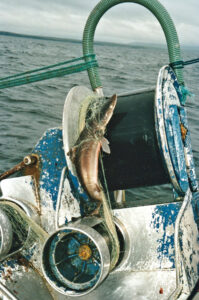
Another spurdog comes through the Spencer Carter hauler.
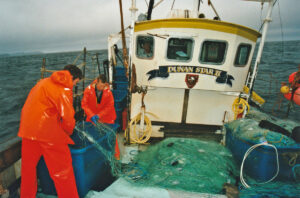
Clearing a tier of nets ready for the next shot.

Removing a solitary dogfish as hauling continues on a slack morning.
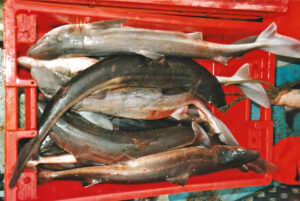
Crewmen Aulay MacKay and Mustaffa Murray clear another fleet of nets into a bin.
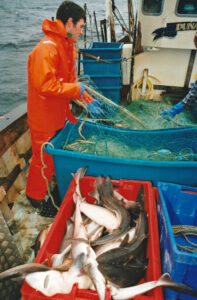
The catch rate improved marginally from nets shot in deeper water.
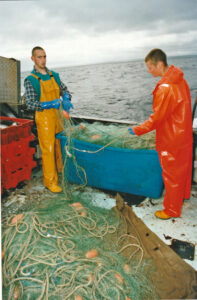
Crewmen Aulay MacKay and Mustaffa Murray clear another fleet of nets into a bin.
With the deepest fishing nets having given slightly better results, skipper Calum MacLeod decided to shoot three tiers of nets north and south on either side of the 25-fathom line. Running before the wind, the nets were cleanly shot out of bins positioned against the starboard gunwale amidships, with the midway nets quickly being joined together.
Reluctant to leave the shallower water completely, as it had given steady fishing the previous week, Calum MacLeod kept one fleet onboard while steaming Dunan Star II in towards the shore at Bragar, to find some shelter to get a late breakfast underway.
While running in, the crew boxed the morning’s work, which unfortunately did not take too long. The crew divided the catch into two grades, large (box length) and mediums, with the result that there were six and four boxes respectively. As was customary, the fish were consigned to George Jack of Fraserburgh, who had taken Dunan Star II’s catches for a long time.
At the time of this trip in mid-July, large spurdogs were bringing around £55 per box, and mediums £45-£50. This was still considered good money at a time when trawled dogfish were selling at £35 per box on the main Scottish markets – although prices earlier in the year, when dogs had been found down to 60 fathoms, had been considerably higher.
After the last tier of nets had been shot in 12 fathoms half a mile off the shore, the crew turned in for 90 minutes while skipper Calum MacLeod headed southwest towards Gallan Head, where he would shoot the whitefish trawl to try and scrape a few more fish together to make a landing.
Multipurpose inshore vessel
Based on a Cygnus GM44 GRP hull and powered by a Gardner 6LXDT 136kW engine driving through a Twin Disc 3:1 reduction gearbox, Dunan Star II was built in 1987. Primarily designed for crabbing, the vessel was also equipped with Spencer Carter 2.5t split trawl winches aft of the wheelhouse, giving the option for trawling.
Between 1987 and 2001, Dunan Star II was modified to meet the changing pattern of inshore fishing, including trawling, netting, jigging and potting.
Trawling
The crew of Dunan Star II came on deck to run the trawl net over the transom rail after skipper Calum MacLeod throttled back the Gardner engine some three miles northwest of Gallan Head.
The 44ft Dunan Star II usually worked a semi-clean ground trawl made by Scotnet of Fraserburgh. Rigged on 120ft of rubbers, this type and size of trawl was well suited to Calum MacLeod’s requirements. It was big enough for the crew to work by hand, and small enough to manoeuvre along some of the tight tows that Dunan Star II worked on the inshore grounds.
Eighteen-fathom bridles and 35 fathoms of combination sweeps followed the trawl into the water, before the No. 7 Bison trawl doors were clipped on and Dunan Star II eased ahead to run off 100 fathoms of 10mm-diameter wire.
When Cygnus Marine delivered Dunan Star II in 1987, the boat had an unusual deck layout, with skipper Calum MacLeod opting for two Spencer Carter 2.5t split trawl winches to be located at the quarters close to the transom stern. This was primarily because he anticipated pair-trawling for hake with a four-panel midwater trawl as one of his main fishing methods, and split winches would have been beneficial in enabling the crucial small adjustments of warp length to be made to the head and foot ropes. Another advantage of the compact split trawl winches was that they could be fitted aft, leaving the fore deck clear for potting and netting activities.
This working arrangement meant that even when carrying fleets of creels or gill-nets forward, the trawl could be shot away immediately from the deck pond situated between the split winches.
As the previously fresh southwesterly wind started to fall away, leaving only a long gentle Atlantic groundswell, the tow commenced into the southeast at less than two knots. With a very strong tide running, Calum MacLeod had decided against going for the tow he had initially favoured while steaming to the trawling grounds. This was a very tight-looking figure of eight loop, with several fasteners clearly marked close on either side of the track displayed on the Furuno GD-188 plotter.
However, he doubted whether Dunan Star II would manage to keep the gear clear of these obstructions when exposed to the tide while turning. Instead, he opted for a more linear tow, starting a mile further to the south, heading towards Gallan Head, which was blacked out by another heavy rain squall.
Fishing in 37 fathoms, the tow was expected to yield a mixture of flatfish, mainly skate and megrim, while a few boxes of haddock, which used to be quite prolific in this area, would be an added bonus.
Three hours after starting the tow, and with the vague outline of Gallan Head, 1.25 miles distant on the port bow, emerging from the gloom, the hydraulics were clutched in and the Bison doors were soon being chained to the trawl gallows. As the sweeps and bridles were wound onto the split trawl winches, the net surfaced, but with no sign of the bag, indicating that haddock had again proved to be virtually non-existent, and that the catch would consist of mainly roker and other flatfish.
After lifting, the Gilson was hooked in, and the codend was taken aboard amidships on the starboard side, using the warping drum of the nearest trawl winch. As expected, some six boxes of mixed groundfish cascaded into boxes positioned on the deck – a disappointing result.
After retying the codend, the net was thrown back into the water, before the trawl was taken aboard. Two sections of the rubber-legged footrope were hoisted up by a lifting rope from the port winch running through blocks atop the wheelhouse, enabling the ground gear to be dropped into the central deck pond at the transom. The crew then hauled in the net and tied it down, before starting to sort and gut the catch while steaming in to Carloway. They berthed 12 hours after leaving the pier that morning, which ended a fairly typical day for the crew of Dunan Star II.
The next day, they changed tactics a little, as after hauling their gill-nets for 22 boxes of dogfish, they headed offshore to haul some crab gear, further reflecting the mixed nature of inshore fishing.
Legitimate concerns expressed – 20 years ago
Having extensive first-hand experience of declining whitefish stocks west of the Outer Hebrides, the late Calum MacLeod voiced concern about several issues that are as pertinent today as they were 20 years ago – and which have still not been addressed.
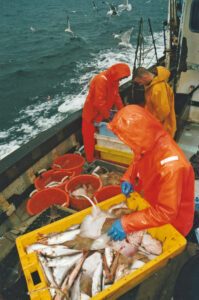
Sorting and gutting the catch while steaming in to Carloway.
He maintained that it was no coincidence that catch rates off Lewis had fallen considerably at a time when the number of large foreign trawlers regularly landing into Lochinver had steadily increased.
“It is unrealistic to talk about zonal management and enhanced control out to six and 12 miles when 60m trawlers are towing night and day on deepwater grounds. These grounds probably provide a large proportion of the stocks of fish that used to populate our inshore waters until a few years ago.
“Grounds a few miles west of Gallan Head, north to the Butt, used to give local and visiting boats from the Moray Firth reliable fishing of both ground and round fish. Now we very rarely see a Scottish trawler, as the grounds are just about barren. Given the large foreign fishing effort being conducted west of the Hebrides, is this any surprise?” asked Calum MacLeod.
“Mature fish in the deep water probably represent stock cycle that results in new year classes, some of which, at some stage in their lives, will inevitably move inshore. This is the stock pattern that has provided a good supply of mixed fish off these shores for generations. Methodically removing a link in the chain by towing large trawls back and forth across the same area of seabed is bound to have serious consequences with regard to the size of the spawning biomass, and therefore the number of young fish joining the fishery each year.
“Yet local fishermen can only watch powerless as foreign trawlers steam out west from the Butt of Lewis to fish in areas that possibly form part of the nursery areas which have traditionally supplied local grounds.”
Skipper Calum MacLeod was equally scathing – and forward-thinking – about the impact that a rapidly growing seal population was having on declining whitefish stocks.
He questioned why the government continued to reduce quotas and fishing opportunities, citing scientific evidence of declining whitefish stock numbers, while ignoring the rapid rise in the numbers of seals acting as predators.




